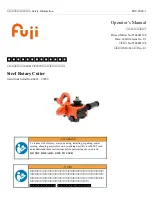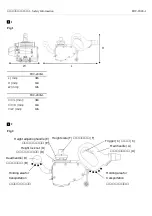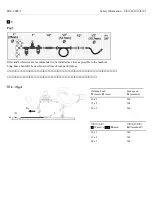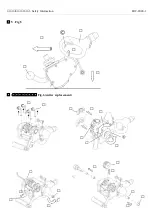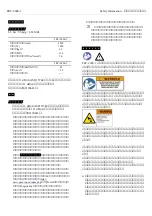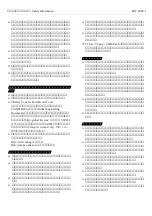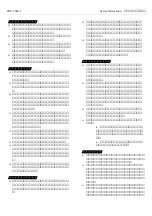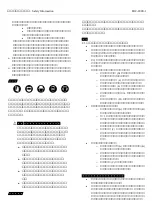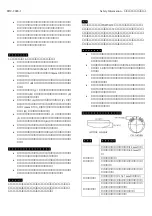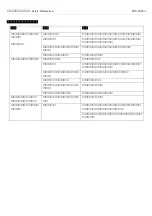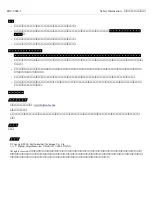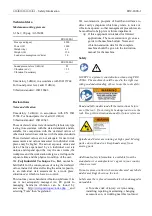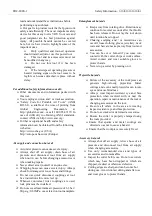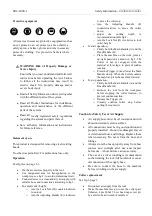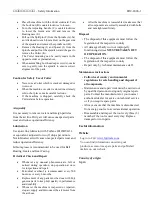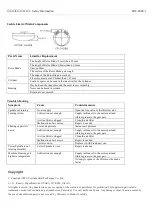
FRC-200S-1
Safety Information -
安全に関する情報
read and understand these instructions before
performing any such task.
Our goal is to produce tools that help you work
safely and efficiently. The most important safety
device for this or any tool is YOU. Your care and
good judgment are the best protection against
injury. All possible hazards cannot be covered
here, but we have tried to highlight some of the
important ones.
Only qualified and trained operators
should install, adjust or use this power tool.
This tool and its accessories must not
be modified in any way.
Do not use this tool if it has been
damaged.
If the rated speed, operating pressure or
hazard warning signs on the tool cease to be
legible or become detached, replace without
delay.
For additional safety information consult:
Other documents and information packed with
this tool.
Your employer, union and / or trade association.
“Safety Code for Portable Air Tools” (ANSI
B186.1), available at the time of printing from
Global
Engineering
Documents
at
http://global.ihs.com/ , or call 1 800 854 7179. In
case of difficulty in obtaining ANSI standards,
contact ANSI via http://www.ansi.org/
Further occupational health and safety
information can be obtained from the following
web sites:
http://www.osha.gov (USA)
http://europe.osha.eu.int (Europe)
Air supply and connection hazards
Air under pressure can cause severe injury.
Always shut off air supply, drain hose of air
pressure and disconnect tool from air supply
when not in use, before changing accessories or
when making repairs.
Never direct air at yourself or anyone else.
Whipping hoses can cause severe injury. Always
check for damaged or loose hoses and fittings.
Do not use quick disconnect couplings at tool.
See instructions for correct set up.
Whenever universal twist couplings are used,
lock pins must be installed.
Do not exceed maximum air pressure of 6.3 bar /
90 psig / 0.63MPa, or as stated on tool nameplate.
Entanglement hazards
Keep away from rotating drive. Rotation may
continue for several seconds after the throttle
has been released. Do not lay the tool down
until rotation has stopped.
Choking, scalping and / or lacerations can
occur if loose clothing, gloves, jewellery, neck
ware and hair are not kept away from tool and
accessories.
You can be cut or burned if you come into
contact with the cutter, chips or work surface.
Avoid contact and wear suitable gloves to
protect hands.
Never stop a cutter by pressing on it.
Projectile hazards
Failure of the accessory or the workpiece can
generate high-velocity projectiles. Metal
cuttings and even small projectiles can injure
eyes and cause blindness.
Always wear impact-resistant eye and face
protection when involved with or near the
operation, repair or maintenance of the tool or
changing accessories on the tool.
Be sure all others in the area are wearing
impact-resistant eye and face protection.
Do not use cracked or deformed accessories.
Ensure the cutter is properly clamped using
the tools provided.
Ensure that sparks and metal cuttings are
directed so as not to cause a hazard.
Ensure that the workpiece is securely fixed.
Accessory hazards
Always shut off air supply, relieve hose of air
pressure and disconnect tool from air supply
when changing accessories.
Use only recommended sizes and types of
accessories and consumables.
Inspect the cutter before use. Do not use cutters
which may have been dropped or which are
chipped, cracked or otherwise defective.
Cutting edges are sharp and can become hot
during use. Avoid contact during and after use
and wear gloves to protect hands.
Summary of Contents for FRC-200S-1
Page 4: ...Safety Information FRC 200S 1 5 Fig 5 6 Fig 6 cutter replacement...
Page 5: ......
Page 6: ...Safety Information FRC 200S 1 JA 6 EN Safety Information 10...
Page 9: ...FRC 200S 1 Safety Information...
Page 10: ...Safety Information FRC 200S 1 2 3 2 3 o D o E o E o 4 o D o A B o 5 o C o A B o o C o...
Page 12: ...Safety Information FRC 200S 1...

